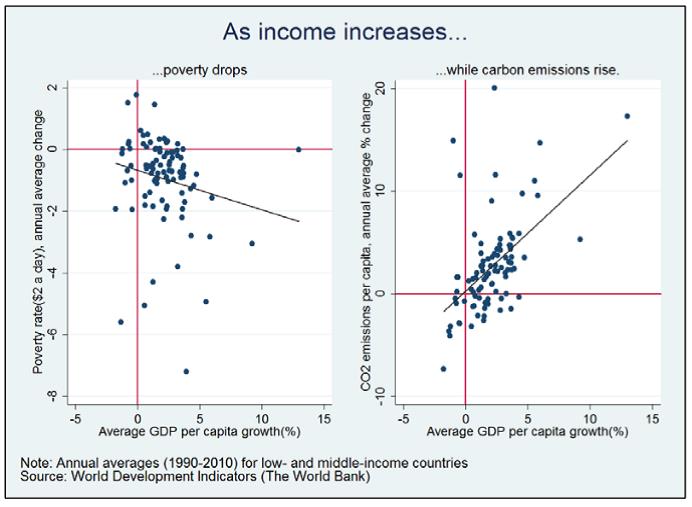Chasing Zero – a wicked problem in the face of a changing climate

By Kristian Gerstner, ACDI Master's student class of 2016
A “wicked problem” is a term our friends over at the Energy Research Centre (ERC) love, and rightly so. Dealing with climate change in itself is a wicked problem, but by incorporating aspects of sustainable development and poverty eradication, you create for yourself a “super wicked problem”. This is where the problem of chasing zero comes into play.
Poverty is an incredibly multifaceted term, incorporating social, economic, and political elements. The key with eliminating poverty is to improve livelihoods, and this is done through enhancing social capital, increasing opportunities, enhancing representation, and creating equality. Many would argue that extreme poverty could be eradicated through redistribution of wealth and earning structures. However, if this solution were easy, we would not be dealing with a wicked problem, and we’d still have the problem of cutting emissions.

Harald Winkler of the ERC presenting at the ERC networking event on emissions and poverty reduction
The Energy Research Centre has been doing a great deal of research on the topic of eradicating poverty whilst simultaneously cutting emissions, which focuses on the two main points of creating a free and equal society through poverty eradication, as well as ensuring long term sustainability through climate change mitigation strategies. The problem here though, is that these two events are not always mutually inclusive. As income increases, poverty decreases, but emissions increase. The question here is how can we create a system where poverty and emissions both decrease? One way to do this would be to redefine what success and wealth are. Getting society, both rich and poor, to see that success does not necessarily translate into high carbon emissions through expensive cars and large houses, and rather just being self-sustaining and comfortable. To do this one would need to rethink wants, needs, and happiness, and teaching that these need not always be objects of opulence.

Above Zero Emissions, Zero Poverty? (2016) (Source: Britta Rennkamp)
I recently attended a seminar held by the Energy Research Centre entitled “Zero emissions, zero poverty?” as well as a networking and discussion event on the topic of emissions and poverty reduction. The networking event allowed for a multi-disciplinary environment in which to discuss the problems surrounding the topic of poverty and emissions. Many issues raised were around the interconnectedness of the two problems, the possibility of poverty reduction in the current global socio-economic environment, and low carbon development that meets the needs of economic growth. One may worry where South Africa is in all of this but steps are being taken by the South African government to tackle these issues, as noted below.


The above graph shows the estimated world population living in poverty. Source: Britta Rennkamp. Zero Emissions, Zero Poverty? (2016).
Interesting to note regarding the above figure on Population Living in Poverty is the steady decline in poverty since 1999. However, there has been a steady incline in Sub-Saharan Africa. Reasons for this include more people moving to urban areas and political instability. However, in South Africa the government is taking steps towards climate action that will reduce the high emissions levels and reduce poverty at the same time.
There are a number of infrastructural developments en route and in place already that aim to reduce reliance on fossil fuels, and make urban living more sustainable and cheaper. For example the Gautrain, a new railway line connecting Johannesburg and Pretoria. On top of this there is a solar water heater program for low income houses and steps are also being taken to reduce illegal and dangerous electricity connections, as well as theft of cables which cause massive infrastructural damage. From a policy side, a carbon tax proposal is under way as well as a white paper on climate change aims to put plans in to reduce greenhouse gas emissions in South Africa.
From the perspective of the author, there are five key areas, adapted from Overseas Development Institute’s paper on “Zero Poverty, Zero Emissions” (2015) that need to be considered when approaching the problem of chasing zero. Firstly, poverty needs to be eradicated through economic growth and equality. Economic growth is tantamount to reducing poverty, but ensuring that all have adequate human capital and access to infrastructure, services and jobs, is just as important. Secondly, none of this will matter if catastrophic climate change is not avoided. The IPCC reports that in order for global temperatures to stay below the 2°C limit, then global GHG emissions would need to reach zero by the end of the century. Thirdly, and this continues on from the second point, if climate change goes on unchecked, around 750 million people could be thrown back into extreme poverty, undoing all the hard work done if poverty eradication is achieved. Fourthly, big GHG emitters need to shift their economies towards zero net emissions pathways. Working on eliminating poverty without doing this is counterproductive. And finally, low emission development needs to be prioritised. Not only as a way of cutting emissions, but as a solution to solving extreme poverty. Emission reduction pathways can be growth-enhancing and developing countries need to take these opportunities to heart.
Disclaimer: The views expressed here are solely those of the author in his private capacity.